Another Triumph of Hope over Experience
On June 4 we learned that the Port of Coos Bay has published a “Business Plan”, which it is required to do by the State of Oregon. Being required to do something often shrinks what little zeal survives in an overpaid bureaucracy, which may explain why the Port’s Business Plan looks like a collection of stale ideas, assembled at a snail’s pace. Perhaps to make up for that the Plan is very long, containing multiple chapters: a “SWOT Analysis”; a “Stakeholder Interview Summary” (SIS); a transcript of a long Port Commission meeting with a toadying consultant described as a “Strategic Planning Session” (SPS); a “Strategic Market Assessment” (SMA), and a “Strategic Business Plan” (SBP). This is not a complete list of the chapters, which together fill over 300 pages. See: http://portofcoosbay.com/DraftStrategicBusinessPlan.pdf
Please bear in mind that for quotes from these various documents I have used the abbreviations above, with page numbers: SIS, SPS, SMA, SBP etcetera. Since the Business Plan had no page numbering system that ran from the first to the last page, that seemed to be the only practical reference system.
After the Plan’s revelation on June 4 the Port only allowed public comments until Friday the 19th, which seemed unfairly short given the length of the Plan and the time the Port allowed itself to create it. Personally, I was unable to meet that deadline; but my consolation is that the Port would have paid no more than perfunctory attention to my points, anyway.
That the Port’s Plan was assembled at a snail’s pace, my first impression, was confirmed by further readings. To begin with, some of the Plan’s parts date from 2013. Secondly, I was struck by repeated statements (SMA pp. ES-i & 7; SBP p. 33) that “World economic growth is expected to accelerate in 2014”, while growth in the U.S. economy “. . . is expected to accelerate gradually for the next five years (through 2018).” 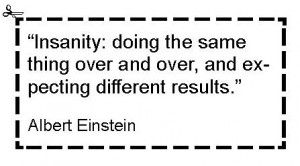 This being mid-2015, they’d better step on it. Has this been languishing in somebody’s bottom drawer? That impression was confirmed by numerous graphs in the Plan’s SMA that show past cargo trends and future projections of those trends. These graphs only show actual numbers through 2009, with projections from then onwards. Surely by now we should have real data through at least 2013.
This being mid-2015, they’d better step on it. Has this been languishing in somebody’s bottom drawer? That impression was confirmed by numerous graphs in the Plan’s SMA that show past cargo trends and future projections of those trends. These graphs only show actual numbers through 2009, with projections from then onwards. Surely by now we should have real data through at least 2013.
Shock and Awe
Of course, if a few outdated numbers were the only flaws in a Business Plan shining with pure brilliance, there would be no need to mention them. But they are symptoms of far more serious problems. One such is the authors’ profound ignorance, both of Coos Bay’s economic history and of recent events affecting the Port’s improbable ambitions. In its historical ignorance, the Plan advances all kinds of “development” schemes that have failed before, some repeatedly, yet it promotes them as the Port’s priorities for the next twenty years. But doing over and over what hasn’t worked in the past not only meets Einstein’s definition of insanity, it is likely to bring us an economic future even more disastrous than the past decades of Port-guided “development”.
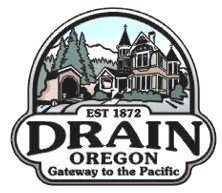 Besides demonstrating their ignorance of history, the Port is also oblivious to more recent developments. It does this by proposing, over and over, the creation of a brand new shipping dock on the North Spit, known as “Oregon Gateway”, at a cost between $80 and $100 million (SMA p. 37; SBP p. 11). As I am reminded every time I pass the big sign describing Drain (pop. 1,151) as “Gateway to the Pacific”: the bigger the words, the less goes on. But as a famous Frenchman also pointed out four hundred years ago, “To establish oneself in the world, one has to do all one can to appear established.”
Besides demonstrating their ignorance of history, the Port is also oblivious to more recent developments. It does this by proposing, over and over, the creation of a brand new shipping dock on the North Spit, known as “Oregon Gateway”, at a cost between $80 and $100 million (SMA p. 37; SBP p. 11). As I am reminded every time I pass the big sign describing Drain (pop. 1,151) as “Gateway to the Pacific”: the bigger the words, the less goes on. But as a famous Frenchman also pointed out four hundred years ago, “To establish oneself in the world, one has to do all one can to appear established.”
The SBP (p.47) mentions that the creation of the Oregon Gateway “. . . multipurpose/multimodal cargo terminal depends on Jordan Cove.” Finally, a smidgen of truth: we learn (SMA p. 4) that a big part – and perhaps the only part – of the Gateway consists of a shipping berth on the western bank of the marine slip that Jordan Cove plans to excavate, with the eastern side “reserved for the Jordan Cove LNG terminal”.
This actually is a regurgitation of an idea first promoted by former Port manager Jeff Bishop back in 2005, when Bishop sought to piggyback the construction of a “modern” cargo terminal for the Port onto Jordan Cove’s moorage slip. Bishop’s genius left his admirers, including bigwigs from the ILWU, “shocked and humbled.” But any reasons for shock and humility have evaporated. In the first place, ten years have passed and nothing happened. Secondly, after submitting contradictory evidence about the moorage slip’s layout during the recent EIS process, Jordan Cove was forced to eliminate the Port’s western berth since it had no clear purpose. 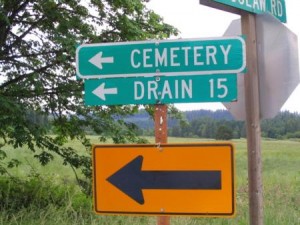 And that’s without considering the huge hazard that a second large vessel inside the slip would pose to an unmoored LNG tanker and its tugboats during the 9.1 earthquake and tsunami that are virtually certain to hit the terminal – if it is ever built.
And that’s without considering the huge hazard that a second large vessel inside the slip would pose to an unmoored LNG tanker and its tugboats during the 9.1 earthquake and tsunami that are virtually certain to hit the terminal – if it is ever built.
Repeating History
The purpose of the west side berth, now quashed but apparently without the Port’s knowledge, was to export “dry bulk commodities” like coal, grain and ore. But not only did the Port lack customers for this plan, the idea demonstrated more historical ignorance, the Port’s and its consultants’.
For example, exporting coal from Utah or Montana was first proposed by a reckless stock promoter in 1979/80. He got Coos Bay all excited over nothing, since the scheme was uneconomical. The extra distance such coal would have to travel by train to Coos Bay would make it more costly than coal exported from Columbia River ports; and in the end those ports never exported any coal either. But because Coos Bay never learns from history, the idea was revived in 2011, with sensational predictions of 100 coal ships sailing annually. Then it died again, but like the cat with a thousand lives, it snuck back into the Port’s present Business Plan.
The idea of shipping grain was first explored in the mid-1980s, and proved just as vain; it suffered from the same problem of unnecessary transportation costs, and unlike Portland, which does ship grain coming down the Columbia River, Coos Bay had no grain silos, and you can’t just store grain out in the open. As a matter of fact, the SMA (p. 37) recognizes that “. . . the average vessel used for transporting dry bulks has been increasing in size, and competing ports in the Columbia River and Puget Sound are more capable than Coos Bay of accommodating these larger vessels. Deepening and widening the channel will increase the competitiveness of Coos Bay.”
But that poses the question of why the federal government would pay for deepening and widening Coos Bay when the needs of bulk carriers are being met by harbors up north. Oh sorry, I forgot: the big crutch holding up the entire creaky structure of the Port’s Business Plan is the Jordan Cove LNG terminal. No Jordan Cove, no deepening and widening; and after due consideration, I set the odds of Jordan Cove not happening at 80%, and rising. That’s because time after time, its promises of having signed sales contracts in hand have gone unfulfilled; and nobody is expecting a recovery of the Asian LNG market, and higher Asian prices, any time soon.
Another fragile crutch holding up the Port’s Plan is its very expensive, very rusty railroad which, as Port Manager Koch puts it, needs a couple of 100-car trains of coal or ore or grain a day to become self-supporting. Aside from the fact that nobody is aching to export coal or grain through Coos Bay, two such trains a day would require improvements far beyond those contemplated now, both in bridge and track upgrades to handle all that weight and in double-tracking the line to accommodate trains coming and going . . . and the railroad’s users will have to be charged for that.
All told, most of the Business Plan faces a very uncertain future, and the Port would have been wise to consider alternatives. But except for a few token remarks about tourism and existing businesses, that’s not what the Port did, most likely because that would alienate its “stakeholders”. So, rather than this being a Business Plan it’s a highly risky gamble with the welfare of the people of the Coos Bay Port District.
Container Shipping?
The SMA (p. ES-iv) mentions container shipping as another reason for the “Gateway” idea, not at the Jordan Cove moorage slip but elsewhere on the North Spit. Its exact location is left unclear, probably because the Port’s past property transactions with DB Western and Southport Lumber have badly divided its usable land, and container terminals need a lot of continuous acreage. The SMA argues (p.39) that in the long run, improvements to the Coos Bay shipping channel and the railroad “may increase interest from container carriers,” although interviewed Port “stakeholders” do warn that in the container business, “Coos Bay can’t compete with San Francisco and Portland.” (SIS p.7)
Unfortunately, every one of these pontifications reveals yet more ignorance. By far the biggest container shipping center on the west coast are the combined Ports of Los Angeles/Long Beach in southern California, with 14.5 million units a year, some three quarters of the over 20 million handled in all west coast harbors. The rest of the container business is divided between Oakland, with over 2 million a year, and Seattle/Tacoma with 3.5. Portland has long been among the small fry, handling 178,000 containers in 2013, or less than one percent of the west coast total. The Port of San Francisco mentioned by the “stakeholders” does not handle containers at all, and last I checked, Portland was thinking of getting rid of Terminal 6, its container facility (shown above), because it has lost millions annually for a long time and now, having lost its last container carriers Hapag/Lloyd and Hanjin, the Port of Portland is encouraging its domestic container shippers to move their cargo through Seattle/Tacoma. So much for Portland being the traditional object of Coos Bay’s envy.
What is interesting too is that according the minutes of the Port’s “Strategic Planning Session” (SPS) of December 18, 2014, included in the Business Plan, a knowledgeable but cloyingly complimentary consultant by the name of Richard Steinke told the Commissioners that “Seattle, Tacoma, Long Beach, and Oakland have way too much container space.” (SPS p. 6; the pages are unnumbered.)
If that’s true, then why would any container shipping company consider coming to Coos Bay, when that would require building a new container terminal plus a huge upgrade of the railroad, which in turn would require a huge investment and/or huge financial guarantees by that shipping company? It may be useful to remember what happened to the Maersk container proposal back in 2007, that was greeted with so much self-congratulatory backslapping by all the Port’s “stakeholders”. Instead of sinking its money into fixed facilities, Maersk ended up leasing an available container terminal in Vancouver, BC. That was a wise move; the shipping business changes all the time, and tying up a billion in a terminal and a railroad may come back to bite a shipper if traffic is not as expected. Besides, the impending opening of the enlarged Panama Canal is likely to depress container volumes in west coast ports by diverting traffic to Gulf and Southern ports. But the Port’s staff is convinced that we “need terminals to generate inbound cargo for RR shipping” (SIS p.6). And on the next page they are advocating passenger service on that same decrepit railroad, and importing automobiles. The mind boggles.
Has BST seen the LIGHT?
One of the strangest aspects of the Port’s Business Plan is that its authors, consultants known as BergerABAM of Hood River, were assisted by yet other consultants including one called BST Associates, of Kenmore, WA, who wrote the Plan’s “Strategic Market Assessment” (SMA), some 50 pages long, its title page decorated with a thirty year old picture of ships and log rafts in Coos Bay. As mentioned, the SMA, and hence BST Associates, is supportive of the Port’s wish to build new cargo terminals. But what puzzles me is whether BST’s support for this may be motivated by its own need to make a living by writing Port Business Plans.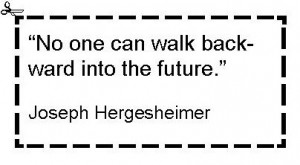 It seems a reasonable question because BST is the same consulting firm that in April 2002 produced a $50,000 report that warned the Port not to build a brand-new, state-of-the-art shipping dock on the North Spit because of insufficient cargo to be expected from the port’s “hinterland”, places like Eugene, Roseburg and Medford, whose limited production for export was more likely to go overseas through the Port of Portland or Seattle/Tacoma, and at lower cost. Evidently since then BST Associates has seen the light, and has helped fill the present Business Plan with gushy predictions of a grand shipping future for Coos Bay.
It seems a reasonable question because BST is the same consulting firm that in April 2002 produced a $50,000 report that warned the Port not to build a brand-new, state-of-the-art shipping dock on the North Spit because of insufficient cargo to be expected from the port’s “hinterland”, places like Eugene, Roseburg and Medford, whose limited production for export was more likely to go overseas through the Port of Portland or Seattle/Tacoma, and at lower cost. Evidently since then BST Associates has seen the light, and has helped fill the present Business Plan with gushy predictions of a grand shipping future for Coos Bay.
The inescapable fact is that both the 2002 BST report and a second study that cost three times as much were totally wasted, either because they were wrong, or because they were right but the Port didn’t like their conclusions, and still doesn’t. This is strongly suggested by those parts of the present Business Plan that report the views of the Port’s “stakeholders”, as they are described. The list of 19 “stakeholders” interviewed by the consultants (on page 10 of the SIS) is limited to people with a personal interest in maintaining the status quo and the political hacks who cater to them, who believe against all evidence that Coos Bay’s past maritime glories can be restored, albeit at great public expense. Having a public agency like the Port dominated by such people guarantees it will never do anything different. Typical of the Port’s present “stakeholders” is one who in 2002 was the most vocal detractor of the BST report that warned against building a new shipping dock. Then-Port Commissioner Ingvar Doessing, who worked for a stevedoring company, believed (and still believes) in the “build it and they will come” development philosophy, which works fine in movies about baseball fields but not so well in reality. Regardless of the 2002 BST report, Doessing implored the Port to “restore the once-powerful maritime industry by building a new, modernly equipped dock on the North Spit”, and damn the torpedoes, in the form of cost estimates then between $30 and $60 million that according to BST would never pay off.
Were the consultants wrong in 2002 but right in 2015, and was Doessing right all along about the wisdom of restoring Coos Bay’s “once-powerful maritime industry”? I don’t think so. One reason is the dismal record of the past such efforts by the Port: still-visible boondoggles like the idle T-Dock and the useless barge slip along with the less-visible tens of millions wasted on studies and other gimmicks to attract shippers and industries.
But the other reason for doubt is that we never had a “powerful maritime industry” in the first place, if by “powerful” Doessing meant one that could stand on its own feet, handling floods of cargo from all over the place, domestic and overseas.
Looking at it this way, we never had a “powerful maritime industry” at all. Ignoring some local produce and coal shipped out during Coos Bay’s early days, nearly all export cargo since has consisted of local wood products, with nothing brought in: ships arrived empty and left full of wood fiber in one form or another. Hence the shipping business was never more than an appendage of the local lumber mills, which owned almost all the docks, and for some time even built their own ships. But without lumber to ship out, the ships and the docks had no raison d’être, and the docks rotted away. With minor exceptions, that was true of every small port in the Northwest; Coos Bay is not a lot different from Eureka or Astoria or Grays Harbor or Port Angeles, or even Newport. But most of those places have done well by abandoning their illusions of grandeur. Not Coos Bay.
A Torrid Torrent of Cloying Compliments
But none of that has given pause to the Port’s staff or commissioners or consultants, all of whom maintain that the Port “is well positioned for continued growth”, is “truly an international port” with a “dedicated and experienced staff”, is “the economic engine for this region”; should “Build more marine terminals” and support Jordan Cove; get “Coos County into eco-development”, etcetera, ad infinitum.
When you read the documents inside the Port’s Business Plan, it’s hard not to wonder at the real cost of all the over-the-top compliments thrown up by the “stakeholders”: Port employees, Port Commissioners, Port Consultants. We have “a good location” and a “vibrant maritime commerce port”; the CBR (the Port’s railroad) is mentioned over and over as “a major contributor to future growth”; and the Jordan Cove LNG terminal, which is predicted to “create” only 150 jobs, is described as something close to Eternal Salvation.
In fact, much of what’s in the Business Plan seems designed mostly to ingratiate the consultants. But this may not be a bad business strategy in the consulting business. After all, consultants are not responsible for what happens to the people they consult for, but their central concern is to be paid for what they do. It follows that they may as well pull out all the stops of their praise-organs or, to put it plainly: suck up to those suckers. Here are some quotes from what consultant Steinke told the Port Commissioners and their lackeys, taken from the minutes of that meeting:
“. . . he congratulated the board and staff for strategic moves they are making on some of the projects they are handling. A lot of ports out there would be very jealous because most ports learn the hard way and respond to opportunities too late. The Port of Coos Bay has a really solid strategy taking care of those stakeholders that need to be accounted for in projects.” (p.5) That is a good question” (p.6). ‘What are the Port’s differentiators here? What does the Port have here besides this tremendous board and great staff that set them apart from other Ports?” (P. 9) “That is a good point” (p. 11). “Good comment” (. 12). “Great question”. (p. 14) “That raises a good question.” (p. 15). “That’s a key point. . . . I congratulate you guys again on this project you are doing.” (p.16) “We are marching through what our ideal terminal is going to look like. It’s all things to all people. It’s the envy of ports around the world.” (p.18) “I applaud you on your strategy with JCEP. . . . I think it is masterful that you guys have developed that.” (p.24) “The board on the other hand, your time is very, very precious . . . You guys are obviously very civic-minded. You are doing this because of your commitment to this community. . . . I am impressed by the depth of knowledge of all of you.” (p. 26) “. . . you guys are really well positioned with being able to control your own destiny. . . . there is some real positive energy that’s going on and an opportunity to make some really exciting progress to start the kind of the beacon for economic advancement and recovery in the area.” (p. 27)
Considering this torrid torrent of cloying compliments, it should not be surprising that Port “CEO” David Koch felt obliged to chime in: “This by far has been the most stable and highly functioning board I have ever had the pleasure to work with. I appreciate that.” (p. 31)
Fine and dandy. But what has any of this achieved? More important, what WILL it achieve? History is not encouraging.

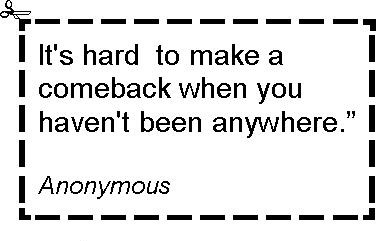
The port is staffed with enough locals that have navigated up the “right channels” that begin at the chamber of commerce. These privileged locals are seen as “leaders” by themselves and their peers that are navigating the same channels. They may go to church, attend local events as near-celebrities and swarm all the other local government bodies when they push their agenda, but they are still getting their marching orders from the governors office. They do what they are told to do by those that have the power of appointment. The port only works for one boss. Kate Brown has inherited the mess we call the port and I doubt she has the fortitude to change its course from a fossil fool future that Kitzhaber envisioned. The pockets behind her chair are to deep and she knows the majority of the democrats representing us have agreed to push Jordan Cove through.
It has now become a moral issue for those involved with promoting Jordan Cove to deal with, thanks to the Pope and others who are fighting for future generations. So far they appear to still have their fingers in their ears.